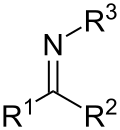Inorganic chemistry, a Schiff base (named after Hugo Schiff) is a compound with the general structure R1R2C=NR3 (R3 = alkyloraryl, but not hydrogen).[1][2] They can be considered a sub-class of imines, being either secondary ketimines or secondary aldimines depending on their structure. Anil refers to a common subset of Schiff bases: imines derived from anilines.[3] The term can be synonymous with azomethine which refers specifically to secondary aldimines (i.e. R−CH=NR' where R' ≠ H).[4]


Schiff bases can be synthesized from an aliphaticoraromatic amine and a carbonyl compound by nucleophilic addition forming a hemiaminal, followed by a dehydration to generate an imine. In a typical reaction, 4,4'-oxydianiline reacts with o-vanillin:[5]
Schiff bases can also be synthesized via the aza-Wittig-reaction.
Schiff bases have been investigated in relation to a wide range of contexts, including antimicrobial, antiviral and anticancer activity. They have also been considered for the inhibition of amyloid-β aggregation.[6]
Schiff bases are common enzymatic intermediates where an amine, such as the terminal group of a lysine residue, reversibly reacts with an aldehyde or ketone of a cofactor or substrate. The common enzyme cofactor pyridoxal phosphate (PLP) forms a Schiff base with a lysine residue and is transaldiminated to the substrate(s).[7] Similarly, the cofactor retinal forms a Schiff base in rhodopsins, including human rhodopsin (via Lysine 296), which is key in the photoreception mechanism.
The term Schiff base is normally applied to these compounds when they are being used as ligands to form coordination complexes with metal ions. One example is Jacobsen's catalyst. The imine nitrogen is basic and exhibits pi-acceptor properties. Several, especially the diiminopyridines are noninnocent ligands. Many Schiff base ligands are derived from alkyl diamines and aromatic aldehydes.[8]
Schiff base ligands
Chiral Schiff bases were one of the first ligands used for asymmetric catalysis. In 1968 Ryōji Noyori developed a copper-Schiff base complex for the metal-carbenoid cyclopropanationofstyrene.[9] Schiff bases have also been incorporated into metal–organic frameworks (MOF).[10]
Conjugated Schiff bases absorb strongly in the UV-visible region of the electromagnetic spectrum. This absorption is the basis of the anisidine value, which is a measure of oxidative spoilage for fats and oils.